Simbo Rig
A SAIL MANAGEMENT SYSTEM FOR SAFER DOWNWIND CRUISING
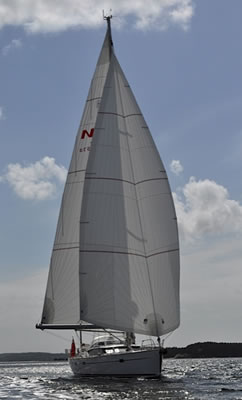 |
The Simbo Rig provides yachtsmen & women with a comprehensive sail management system based on the flying of identical twin jibs with their higher cut clew. This enables the short handed skipper to sail efficiently on all points of the wind with minimum foredeck work, controlled from the security of the cockpit. Simbo Rig which is an acronym for Simple Bow Rig, may be of particular interest to sailors who are not only sailing larger and more powerful yachts but on longer passages, often involving many weeks at sea. The merit of the rig is that it enables the crew to sail efficiently and safely, dead downwind without resorting to coloured sails. With the Simbo Rig however, the working sails are always to hand to enable a skipper to make an immediate course correction to avoid collision i.e. semi submerged container unit or return upwind to retrieve a MOB.
This sail management system permits you to complete a passage or season with just the one suit of sails, no matter whether sailing to weather, bearing away on a reach or running dead downwind. Apart from the raising and stowing of whisker poles, no further foredeck work is required and with in-mast mainsail and jib furling, one person can control the rig from the security of the cockpit through day and night, in fair or foul weather without necessarily calling upon off-watch crew. Assuming of course, that the yacht is under the control of a reliable auto-pilot.
The identical jibs are hoisted up the twin grooves of a furling forestay on a single halyard. On the wind, the sails fly together with no appreciable additional wear over that of a solo jib. The jibs and inmast furling mainsail in the attaching photographs, were constructed by UK Sailmakers in dimension polyant’s hydranet woven cloth which is a hybrid of woven polyester with a spectra ripstop.
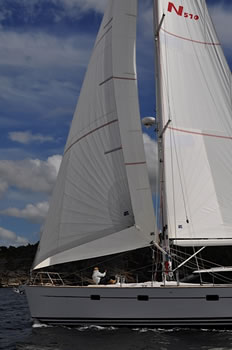 |
On the wind, the twin jibs enable you to rest the upwind sail on its downwind partner to re-run the sheet from the clew, from outside to inside the cap shroud for a tighter sheeting angle; in the same way, you can also run an otherwise loaded jib car up the track without in either case, incurring flogging sails or loss of boat speed.
On tacking through the wind, the upwind leeward jib/sheet is released to rest on its downwind twin to leave just the downwind sheet to be freed on coming about. Once through the wind, the new downwind jib/sheet captures its upwind partner and trimmed to the new course, the upwind jib sheet then takes over final trimming. On reefing or striking the jibs, both sails furl around the forestay in the same way as a solo jib. However, in strong winds it may be preferable for larger yachts with greater sail area requiring powered furling, to furl the jibs from around the leeward bow to enable the skipper to more easily luff the sails and reduce the pressure on the furling mechanism. As opposed to furling them across the foredeck directly into the wind with remaining residue pressure in the sails . As the two sails have their own set of sheets independent of each other, there is double the quantity in the cockpit but this can be simplified by their being colour coded.
The system excels when the yacht bears off to a run. The twin jibs separate to their respective side to create a powerful cloud of sail in harmony with the mainsail, to power the yacht downwind. With the mainsail eased to 45-degrees off the centre line, the captured wind is redirected around the mast into the weather jib which together with its own accumulated wind, is dispatched into the leeward jib that would otherwise have been blanketed by the mainsail.To expedite a gybe, simply haul and release the mainsheet/sail trimmed to the new course, leaving the whisker poles and jib sheets unaffected.
Prior to bearing away to a run, one can raise the weather whisker pole on its boom-lift with attaching fore & aft guys with the weather lazy sheets from both jibs run through the whisker pole's claw and captured by its retaining retractable bolt. This enables the twin jibs to be separated immediately on coming onto a run.
 |
|
| Note the true wind shown by the ensign compared with the apparent wind from the mainsail, displayed by the courtesy flag. This generated apparent wind greatly increases the pressure into the twin jibs to enable them to fly without whisker poles | |
If remaining on that tack there is no need to hoist the leeward whisker pole as it is the redirected wind from the weather jib that sets the sail. On subsequently requiring to gybe, the leeward whisker pole can be attached without loss of drive, by restraining the sail by its lazy weather sheet whilst rigging the leeward whisker pole on its boom lift with fore & aft guys and running the slackened leeward sheets through the W/P claw. Following this, the sail’s retention can be transferred back to the poled out leeward sheet. A more relaxed approach to rigging the whisker poles is to furl away the jibs on bearing off to a run, hoist the whisker poles and then unfurl the sails to their respective side. However, If running dead downwind i.e. with the true wind no more than 20 degrees off the stern, the twin jibs will set without the whisker poles by running the jib sheet-cars forward on their track, to tighten the jibs’ sheets/leech down on them to cup the sails.
The twin jibs can be reefed downwind by furling the sails from their respective side around the jib foil. If hit by a squall though, one can immediately dump 50% of the sail area by bearing onto the wind to back the weather jib to leeward. The jibs can then be reefed under the lee of the mainsail before separating them again on returning to the run. If running in severe weather when the mainsail has been struck in favour of the twin jibs, it is consoling to know that the remaining sail area can be reduced by 50% merely by backing the weather jib to leeward, when one can then continue the run with the jibs poled out in tandem to leeward. Following on from this, the twin sails can be reefed in tandem or struck without incurring any foredeck work and all from the security of the cockpit. The whisker poles can be retained on a reach until the apparent wind is approximately 65 degrees off the bow when the leeward sheets are released by withdrawing the restraining bolt at the W/P claw. The poles can then be stowed up the mast or left in situ for subsequently returning to a run.
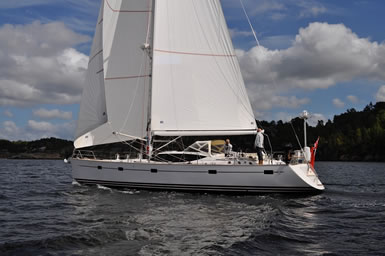 |
|---|
On the run the dominant twin jibs lift the bow to create course stability and avert a broach. When taking this into consideration with the ability to reef the headsails downwind, a well found ocean yacht should be able to run with the Simbo Rig in gale force winds without undue concern. I had a personal experience sailing a Najad 460 between the Azores and England in c2004, when caught by a 50 knots squall under full Simbo Rig which lifted the yacht onto a plane and continued sailing dead downwind at 15.5 Kts. SOG, without any inclination to broach or deviate off course. Since then I have sailed all three of the yachts I have owned over the last 17 years i.e. N460, N511 and the current N570 in several gales under total command and confidence from the security of the cockpit. As there is no pressure of significance on the mast from the leeward W/P and the mainsail's boom only opposes the weather W/P at 45 degrees, downwind roll is reduced to a minimum.
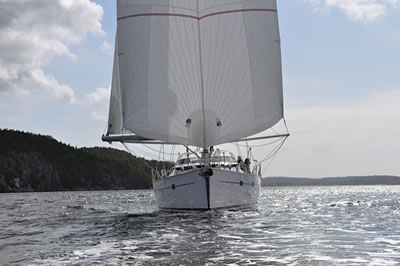 |
The main attributes of the Simbo Rig are that it permits the skipper to sail on all points of the wind with the one suit of sails with minimum foredeck work and most importantly, power downwind without compromising the working rig which is always to hand to deal with unforeseen circumstances.
For yachts with no forward lowers, the whisker poles can be jointly stowed up a forward mounted mast track and lowered like wings, to pre-marked settings on their boom-lifts and attaching fore & aft guys which ensures that the W/Ps are at right angles to both the yacht and the mast. For yachts with forward lowers, the whisker poles are manually stowed up the mast and subsequently rigged between the fore and aft lowers by attaching the inboard end to a hinged male mast fitting. In either case, carbon whisker poles are to be preferred at a length of 50% of the jib’s foot, measured from tack to clew.
Before returning to a run, furl-in a few rolls of the jibs to avoid hooking the upwind jib leech on the mast radome when sheeting it back to weather |
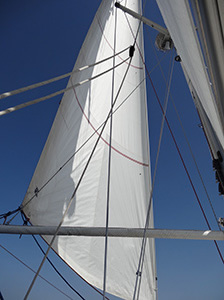 |
P.S. for those who would like to deploy the Simbo Rig for an ocean passage by way of improvisation but avoid any permanent commitment, I would highly recommend their consulting SV Bora Bora’s most informative and excellently scripted account on YouTube of their three years cruise. This took Ben and Niki from Falmouth, England via the Balearics to Cape Verde, Caribbean, E. coast USA and return to Cornwall via the Azores during which they deployed the Simbo Rig from episode 9, by supplementing their existing genoa with a similar but not identical additional genoa. This professionally produced and scripted action packed series of videos provide a great example of first class seamanship, highest degree of competence and a lesson to us all on the importance of self reliance. Bora Bora Videos
N.B. for further relevant information 'click here’
Video of the twin jibs being deployed to run dead downwind in 10 knots T.W.S.
 The Simbo Rig
The Simbo Rig Spd 4.5kts. SOG 4.4kts. TWS 9.6kts. AWS 4.5kts.
Spd 4.5kts. SOG 4.4kts. TWS 9.6kts. AWS 4.5kts. twin jibs in harmony with mainsail
twin jibs in harmony with mainsail Spd 10.4kt. SOG 9.6kts. TWS 24.5kts. AWS 25kts.
Spd 10.4kt. SOG 9.6kts. TWS 24.5kts. AWS 25kts. reefed Simbo Rig without W/Ps. No foredeck work!
reefed Simbo Rig without W/Ps. No foredeck work! Spd 11.4kts. SOG 9.5kts. TWS 28.7kts. AWS 18.5kts.
Spd 11.4kts. SOG 9.5kts. TWS 28.7kts. AWS 18.5kts. mainsail redirects wind into the leeward jib via the weather twin
mainsail redirects wind into the leeward jib via the weather twin Spd. 9.9kts. SOG 9.4kts. TWS 24.1kts. AWS 15.2kts.
Spd. 9.9kts. SOG 9.4kts. TWS 24.1kts. AWS 15.2kts. Twin jibs lift bow to create downwind stability, particularly relevant in strong weather!
Twin jibs lift bow to create downwind stability, particularly relevant in strong weather! Spd.10.1kts. SOG 9.7kts. TWS 24.5kts. AWS 15.7kts.
Spd.10.1kts. SOG 9.7kts. TWS 24.5kts. AWS 15.7kts. N.B. WP with boom lift, fore&aft guys, red weather sheet with lazy blue leeward sheet across deck for reaching
N.B. WP with boom lift, fore&aft guys, red weather sheet with lazy blue leeward sheet across deck for reaching identical set up to leeward plus mainboom preventer
identical set up to leeward plus mainboom preventer Spd 10.1kts. SOG 9.4Kts. TWS 25.6kts. AWS16.8kts.
Spd 10.1kts. SOG 9.4Kts. TWS 25.6kts. AWS16.8kts. N.B. Apparent wind off mainsail from Greek courtesy flag directed into weather jib
N.B. Apparent wind off mainsail from Greek courtesy flag directed into weather jib Spd 6.7kts. SOG 6.5kts. TWS 10.4kts. AWS 3.9kts.
Spd 6.7kts. SOG 6.5kts. TWS 10.4kts. AWS 3.9kts. reef the mainsail before reefing jibs to retain stability
reef the mainsail before reefing jibs to retain stability the accompanying weather jib to previous photo
the accompanying weather jib to previous photo to return to a reach from a run, merely back weather jib to leeward & continue, from the security of the cockpit!
to return to a reach from a run, merely back weather jib to leeward & continue, from the security of the cockpit! each jib has its own set of sheets returned to cockpit winches via track cars & turning block
each jib has its own set of sheets returned to cockpit winches via track cars & turning block  Spd. 12.6kts. SOG 10.1kts. TWS 29.1kts. AWS 17.9kts.
Spd. 12.6kts. SOG 10.1kts. TWS 29.1kts. AWS 17.9kts. only require weather W/P unless needing to gybe, when leeward W/P can easily be erected
only require weather W/P unless needing to gybe, when leeward W/P can easily be erected  just back jib to return to a reach (from the cockpit!) in TWS 29.6kts. AWS 25.5kts. Spd. 10.8kts. SOG 9.3kts.
just back jib to return to a reach (from the cockpit!) in TWS 29.6kts. AWS 25.5kts. Spd. 10.8kts. SOG 9.3kts.  only need to haul the mainsail/sheet to gybe. Twin jibs/sheets remain unaffected!
only need to haul the mainsail/sheet to gybe. Twin jibs/sheets remain unaffected! N.B. blanketed leeward jib tell-tales!
N.B. blanketed leeward jib tell-tales! strike the mainsail from astern & relax with 2 crew under twin jibs overnight (one on watch) in TWS 34.8kts. AWS 25kts, Spd 12kts. SOG 10.4kts. !
strike the mainsail from astern & relax with 2 crew under twin jibs overnight (one on watch) in TWS 34.8kts. AWS 25kts, Spd 12kts. SOG 10.4kts. ! reef mainsail from astern, come to weather, back the weather jib & return to a reach in 28.5 TWS, from the security of the cockpit!
reef mainsail from astern, come to weather, back the weather jib & return to a reach in 28.5 TWS, from the security of the cockpit! I almost forgot, and relax!
I almost forgot, and relax! That’s it. W/Ps with fore & aft guys + boom lifts, red running sheets + blue lazy reaching sheets and mainboom preventer.
That’s it. W/Ps with fore & aft guys + boom lifts, red running sheets + blue lazy reaching sheets and mainboom preventer.